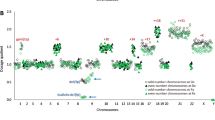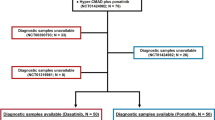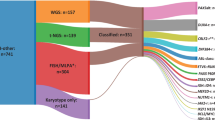Abstract
Oncogenic subtypes in childhood B-cell precursor acute lymphoblastic leukemia (BCP-ALL) are used for risk stratification. However, a significant number of BCP-ALL patients are still genetically unassigned. Using array-comparative genomic hybridization in a selected BCP-ALL cohort, we characterized a recurrent V(D)J-mediated intragenic deletion of the ERG gene (ERGdel). A breakpoint-specific PCR assay was designed and used to screen an independent non-selected cohort of 897 children aged 1–17 years treated for BCP-ALL in the EORTC-CLG 58951 trial. ERGdel was found in 29/897 patients (3.2%) and was mutually exclusive of known classifying genetic lesions, suggesting that it characterized a distinct leukemia entity. ERGdel was associated with higher age (median 7.0 vs 4.0 years, P=0.004), aberrant CD2 expression (43.5% vs 3.7%, P<0.001) and frequent IKZF1 Δ4-7 deletions (37.9% vs 5.3%, P<0.001). However, ERGdel patients had a very good outcome, with an 8-year event-free survival (8-y EFS) and an 8-year overall survival of 86.4% and 95.6%, respectively, suggesting that the IKZF1 deletion had no impact on prognosis in this genetic subtype. Accordingly, within patients with an IKZF1 Δ4-7 deletion, those with ERGdel had a better outcome (8-y EFS: 85.7% vs 51.3%; hazard ratio: 0.16; 95% confidence interval: 0.02–1.20; P=0.04). These findings have implications for further stratification including IKZF1 status.
This is a preview of subscription content, access via your institution
Access options
Subscribe to this journal
Receive 12 print issues and online access
$259.00 per year
only $21.58 per issue
Buy this article
- Purchase on Springer Link
- Instant access to full article PDF
Prices may be subject to local taxes which are calculated during checkout




Similar content being viewed by others
References
Szczepanski T, Harrison CJ, van Dongen JJ . Genetic aberrations in paediatric acute leukaemias and implications for management of patients. Lancet Oncol 2010; 11: 880–889.
Moorman AV . The clinical relevance of chromosomal and genomic abnormalities in B-cell precursor acute lymphoblastic leukaemia. Blood Rev 2012; 26: 123–135.
Tijchon E, Havinga J, van Leeuwen FN, Scheijen B . B-lineage transcription factors and cooperating gene lesions required for leukemia development. Leukemia 2013; 27: 541–552.
Yeoh EJ, Ross ME, Shurtleff SA, Williams WK, Patel D, Mahfouz R et al. Classification, subtype discovery, and prediction of outcome in pediatric acute lymphoblastic leukemia by gene expression profiling. Cancer Cell 2002; 1: 133–143.
Moorman AV, Ensor HM, Richards SM, Chilton L, Schwab C, Kinsey SE et al. Prognostic effect of chromosomal abnormalities in childhood B-cell precursor acute lymphoblastic leukaemia: results from the UK Medical Research Council ALL97/99 randomised trial. Lancet Oncol 2010; 11: 429–438.
Mullighan CG, Miller CB, Radtke I, Phillips LA, Dalton J, Ma J et al. BCR-ABL1 lymphoblastic leukaemia is characterized by the deletion of Ikaros. Nature 2008; 453: 110–114.
Iacobucci I, Storlazzi CT, Cilloni D, Lonetti A, Ottaviani E, Soverini S et al. Identification and molecular characterization of recurrent genomic deletions on 7p12 in the IKZF1 gene in a large cohort of BCR-ABL1-positive acute lymphoblastic leukemia patients: on behalf of Gruppo Italiano Malattie Ematologiche dell'Adulto Acute Leukemia Working Party (GIMEMA AL WP). Blood 2009; 114: 2159–2167.
Kuiper RP, Schoenmakers EF, van Reijmersdal SV, Hehir-Kwa JY, van Kessel AG, van Leeuwen FN et al. High-resolution genomic profiling of childhood ALL reveals novel recurrent genetic lesions affecting pathways involved in lymphocyte differentiation and cell cycle progression. Leukemia 2007; 21: 1258–1266.
Mullighan CG, Su X, Zhang J, Radtke I, Phillips LA, Miller CB et al. Deletion of IKZF1 and prognosis in acute lymphoblastic leukemia. N Engl J Med 2009; 360: 470–480.
Kuiper RP, Waanders E, van der Velden VH, van Reijmersdal SV, Venkatachalam R, Scheijen B et al. IKZF1 deletions predict relapse in uniformly treated pediatric precursor B-ALL. Leukemia 2010; 24: 1258–1264.
Waanders E, van der Velden VH, van der Schoot CE, van Leeuwen FN, van Reijmersdal SV, de Haas V et al. Integrated use of minimal residual disease classification and IKZF1 alteration status accurately predicts 79% of relapses in pediatric acute lymphoblastic leukemia. Leukemia 2011; 25: 254–258.
Chen IM, Harvey RC, Mullighan CG, Gastier-Foster J, Wharton W, Kang H et al. Outcome modeling with CRLF2, IKZF1, JAK, and minimal residual disease in pediatric acute lymphoblastic leukemia: a Children’s Oncology Group study. Blood 2012; 119: 3512–3522.
Buitenkamp TD, Pieters R, Gallimore NE, van der Veer A, Meijerink JP, Beverloo HB et al. Outcome in children with Down’s syndrome and acute lymphoblastic leukemia: role of IKZF1 deletions and CRLF2 aberrations. Leukemia 2012; 26: 2204–2211.
Dorge P, Meissner B, Zimmermann M, Moericke A, Schrauder A, Bourquin JP et al. IKZF1 deletion is an independent predictor of outcome in pediatric acute lymphoblastic leukemia treated according to the ALL-BFM 2000 protocol. Haematologica 2012; 98: 428–432.
Mi JQ, Wang X, Yao Y, Lu HJ, Jiang XX, Zhou JF et al. Newly diagnosed acute lymphoblastic leukemia in China (II): prognosis related to genetic abnormalities in a series of 1091 cases. Leukemia 2012; 26: 1507–1516.
Ofverholm I, Tran AN, Heyman M, Zachariadis V, Nordenskjold M, Nordgren A et al. Impact of IKZF1 deletions and PAX5 amplifications in pediatric B-cell precursor ALL treated according to NOPHO protocols. Leukemia 2013; 27: 1936–1939.
Mullighan CG, Miller CBS, Su X, Radtke I, Dalton J, Song G et al. ERG deletions define a novel subtype of B-progenitor acute lymphoblastic leukemia. Blood 2007; 110, abstract 691.
Harvey RC, Mullighan CG, Wang X, Dobbin KK, Davidson GS, Bedrick EJ et al. Identification of novel cluster groups in pediatric high-risk B-precursor acute lymphoblastic leukemia with gene expression profiling: correlation with genome-wide DNA copy number alterations, clinical characteristics, and outcome. Blood 2010; 116: 4874–4884.
De Moerloose B, Suciu S, Bertrand Y, Mazingue F, Robert A, Uyttebroeck A et al. Improved outcome with pulses of vincristine and corticosteroids in continuation therapy of children with average risk acute lymphoblastic leukemia (ALL) and lymphoblastic non-Hodgkin lymphoma (NHL): report of the EORTC randomized phase 3 trial 58951. Blood 2010; 116: 36–44.
Guidal C, Vilmer E, Grandchamp B, Cave H . A competitive PCR-based method using TCRD, TCRG and IGH rearrangements for rapid detection of patients with high levels of minimal residual disease in acute lymphoblastic leukemia. Leukemia 2002; 16: 762–764.
van der Velden VH, Panzer-Grumayer ER, Cazzaniga G, Flohr T, Sutton R, Schrauder A et al. Optimization of PCR-based minimal residual disease diagnostics for childhood acute lymphoblastic leukemia in a multi-center setting. Leukemia 2007; 21: 706–713.
Dastugue N, Suciu S, Plat G, Speleman F, Cave H, Girard S et al. Hyperdiploidy with 58–66 chromosomes in childhood B-acute lymphoblastic leukemia is highly curable: 58951 CLG-EORTC results. Blood 2013; 121: 2415–2423.
Caye A, Beldjord K, Mass Malo K, Drunat S, Soulier J, Gandemer V et al. Breakpoint-specific multiplex PCR allows the detection of IKZF1 intragenic deletions and minimal residual disease monitoring in B-cell precursor acute lymphoblastic leukemia. Haematologica 2012; 98: 597–601.
Clappier E, Gerby B, Sigaux F, Delord M, Touzri F, Hernandez L et al. Clonal selection in xenografted human T cell acute lymphoblastic leukemia recapitulates gain of malignancy at relapse. J Exp Med 2011; 208: 653–661.
Conter V, Bartram CR, Valsecchi MG, Schrauder A, Panzer-Grumayer R, Moricke A et al. Molecular response to treatment redefines all prognostic factors in children and adolescents with B-cell precursor acute lymphoblastic leukemia: results in 3184 patients of the AIEOP-BFM ALL 2000 study. Blood 2010; 115: 3206–3214.
Tomlins SA, Rhodes DR, Perner S, Dhanasekaran SM, Mehra R, Sun XW et al. Recurrent fusion of TMPRSS2 and ETS transcription factor genes in prostate cancer. Science 2005; 310: 644–648.
Sorensen PH, Lessnick SL, Lopez-Terrada D, Liu XF, Triche TJ, Denny CT . A second Ewing's sarcoma translocation, t(21;22), fuses the EWS gene to another ETS-family transcription factor, ERG. Nat Genet 1994; 6: 146–151.
Shimizu K, Ichikawa H, Tojo A, Kaneko Y, Maseki N, Hayashi Y et al. An ets-related gene, ERG, is rearranged in human myeloid leukemia with t(16;21) chromosomal translocation. Proc Natl Acad Sci USA 1993; 90: 10280–10284.
Marcucci G, Baldus CD, Ruppert AS, Radmacher MD, Mrozek K, Whitman SP et al. Overexpression of the ETS-related gene, ERG, predicts a worse outcome in acute myeloid leukemia with normal karyotype: a Cancer and Leukemia Group B study. J Clin Oncol 2005; 23: 9234–9242.
Baldus CD, Burmeister T, Martus P, Schwartz S, Gokbuget N, Bloomfield CD et al. High expression of the ETS transcription factor ERG predicts adverse outcome in acute T-lymphoblastic leukemia in adults. J Clin Oncol 2006; 24: 4714–4720.
Loughran SJ, Kruse EA, Hacking DF, de Graaf CA, Hyland CD, Willson TA et al. The transcription factor Erg is essential for definitive hematopoiesis and the function of adult hematopoietic stem cells. Nat Immunol 2008; 9: 810–819.
Taoudi S, Bee T, Hilton A, Knezevic K, Scott J, Willson TA et al. ERG dependence distinguishes developmental control of hematopoietic stem cell maintenance from hematopoietic specification. Genes Dev 2011; 25: 251–262.
Salek-Ardakani S, Smooha G, de Boer J, Sebire NJ, Morrow M, Rainis L et al. ERG is a megakaryocytic oncogene. Cancer Res 2009; 69: 4665–4673.
Thoms JA, Birger Y, Foster S, Knezevic K, Kirschenbaum Y, Chandrakanthan V et al. ERG promotes T-acute lymphoblastic leukemia and is transcriptionally regulated in leukemic cells by a stem cell enhancer. Blood 2011; 117: 7079–7089.
Zaliova M, Zimmermanova O, Dörge P, Eckert C, Möricke A, Zimmermann M et al. ERG deletion is associated with CD2 and attenuates the negative impact of IKZF1 deletion in childhood acute lymphoblastic leukemia. Leukemia, e-pub ahead of print 18 October 2013; doi:10.1038/leu.2013.282.
Den Boer ML, van Slegtenhorst M, De Menezes RX, Cheok MH, Buijs-Gladdines JG, Peters ST et al. A subtype of childhood acute lymphoblastic leukaemia with poor treatment outcome: a genome-wide classification study. Lancet Oncol 2009; 10: 125–134.
Roberts KG, Morin RD, Zhang J, Hirst M, Zhao Y, Su X et al. Genetic alterations activating kinase and cytokine receptor signaling in high-risk acute lymphoblastic leukemia. Cancer Cell 2012; 22: 153–166.
Collins-Underwood JR, Mullighan CG . Genomic profiling of high-risk acute lymphoblastic leukemia. Leukemia 2010; 24: 1676–1685.
Acknowledgements
This work was supported by the Laurette Fugain foundation and the EORTC Charitable Trust. We thank Daniela Geromin from the St-Louis Hospital’s Tumor Biobank for managing patient biological samples. We thank Seraphine Rossi and Lies Mierlaen from EORTC Headquarters. We thank Mélanie Pannetier of the Hematology Laboratory, Robert Debré hospital. We thank S Rasika for English editing of the manuscript. We thank the many clinicians and biologists who took care of the patients enrolled in the EORTC-CLG 58951 study.
Author information
Authors and Affiliations
Corresponding authors
Ethics declarations
Competing interests
SSa is employed by MRC-Holland. The remaining authors declare no conflict of interest.
Additional information
Supplementary Information accompanies this paper on the Leukemia website
Supplementary information
Rights and permissions
About this article
Cite this article
Clappier, E., Auclerc, MF., Rapion, J. et al. An intragenic ERG deletion is a marker of an oncogenic subtype of B-cell precursor acute lymphoblastic leukemia with a favorable outcome despite frequent IKZF1 deletions. Leukemia 28, 70–77 (2014). https://doi.org/10.1038/leu.2013.277
Received:
Revised:
Accepted:
Published:
Issue Date:
DOI: https://doi.org/10.1038/leu.2013.277
Keywords
This article is cited by
-
Whole genome sequencing provides comprehensive genetic testing in childhood B-cell acute lymphoblastic leukaemia
Leukemia (2023)
-
Integrative genomic analysis of childhood acute lymphoblastic leukaemia lacking a genetic biomarker in the UKALL2003 clinical trial
Leukemia (2023)
-
Characterization of novel, recurrent genomic rearrangements as sensitive MRD targets in childhood B-cell precursor ALL
Blood Cancer Journal (2019)
-
Copy number alterations in B-cell development genes, drug resistance, and clinical outcome in pediatric B-cell precursor acute lymphoblastic leukemia
Scientific Reports (2019)
-
High STAP1 expression in DUX4-rearranged cases is not suitable as therapeutic target in pediatric B-cell precursor acute lymphoblastic leukemia
Scientific Reports (2018)



